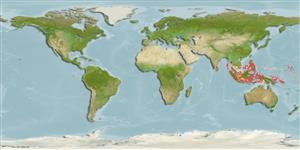>
Gobiiformes (Gobies) >
Gobiidae (Gobies) > Gobiinae
Etymology: Amblyeleotris: Greek, amblys = darkness + The name of a Nile fish, eleotris (Ref. 45335).
Eponymy: Surgeon Major H R F Fontanes was a Dutch East Indian Army physician in Macassar, Celebes. He provided a collection of fishes from Bulucumba, Sulawesi, Indonesia, presumably including the type of the goby. (Ref. 128868), visit book page.
More on author: Bleeker.
Environment: milieu / climate zone / depth range / distribution range
Écologie
marin; saumâtre récifal; profondeur 5 - 30 m (Ref. 90102). Tropical; 19°N - 9°S
Western Pacific: Sumatra to the Moluccas, north to the Philippines; Palau in Micronesia. Reported from Papua New Guinea (Ref. 6771) and south of Taiwan (Ref. 5193).
Taille / Poids / Âge
Maturity: Lm ? range ? - ? cm
Max length : 25.0 cm SL mâle / non sexé; (Ref. 48637)
Description synthétique
Clés d'identification | Morphologie | Morphométrie
Épines dorsales (Total) : 7; Rayons mous dorsaux (Total) : 15; Épines anales: 1; Rayons mous anaux: 16 - 17. Characterized by whitish body color; head and body with five brown bars; small orange spots on head; first dorsal fin with large dark blotch; pelvic fins fully united with well developed frenum; predorsal scales extending forward to less than orbit diameter from interorbital space; longitudinal scale series 110; greatest depth of body 5.8-6.3 in SL; pointed caudal fin, longer than head (Ref. 90102).
Inhabits silty inshore bottoms, deep coastal mud slopes and also occurs in estuaries in muddy channels (Ref. 48637). Also found in sand bottoms of lagoons and sheltered reefs in 5-30 m (Ref. 90102).
Life cycle and mating behavior
Maturité | Reproduction | Frai | Œufs | Fécondité | Larves
Myers, R.F., 1991. Micronesian reef fishes. Second Ed. Coral Graphics, Barrigada, Guam. 298 p. (Ref. 1602)
Statut dans la liste rouge de l'IUCN (Ref. 130435: Version 2024-1)
Menace pour l'homme
Harmless
Utilisations par l'homme
Pêcheries: commercial; Aquarium: Commercial
Outils
Articles particuliers
Télécharger en XML
Sources Internet
Estimates based on models
Preferred temperature (Ref.
123201): 28.4 - 29.3, mean 28.8 °C (based on 1002 cells).
Phylogenetic diversity index (Ref.
82804): PD
50 = 0.5000 [Uniqueness, from 0.5 = low to 2.0 = high].
Bayesian length-weight: a=0.00724 (0.00339 - 0.01546), b=3.10 (2.92 - 3.28), in cm total length, based on LWR estimates for this (Sub)family-body shape (Ref.
93245).
Niveau trophique (Ref.
69278): 3.5 ±0.4 se; based on size and trophs of closest relatives
Résilience (Ref.
120179): Milieu, temps minimum de doublement de population : 1,4 à 4,4 années (Preliminary K or Fecundity.).
Fishing Vulnerability (Ref.
59153): Low vulnerability (21 of 100).
